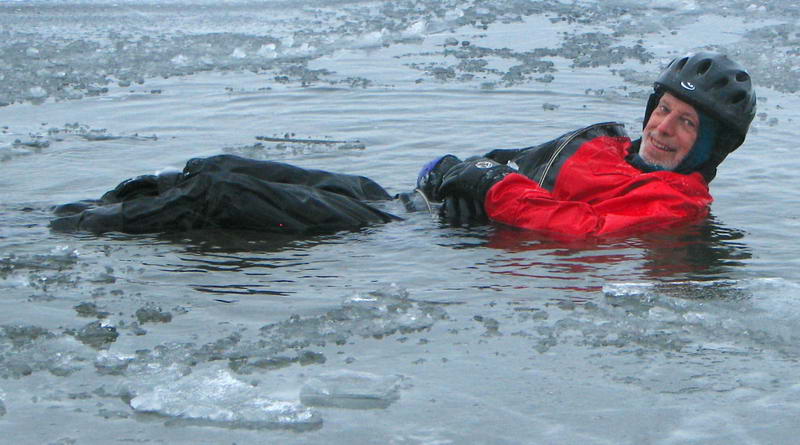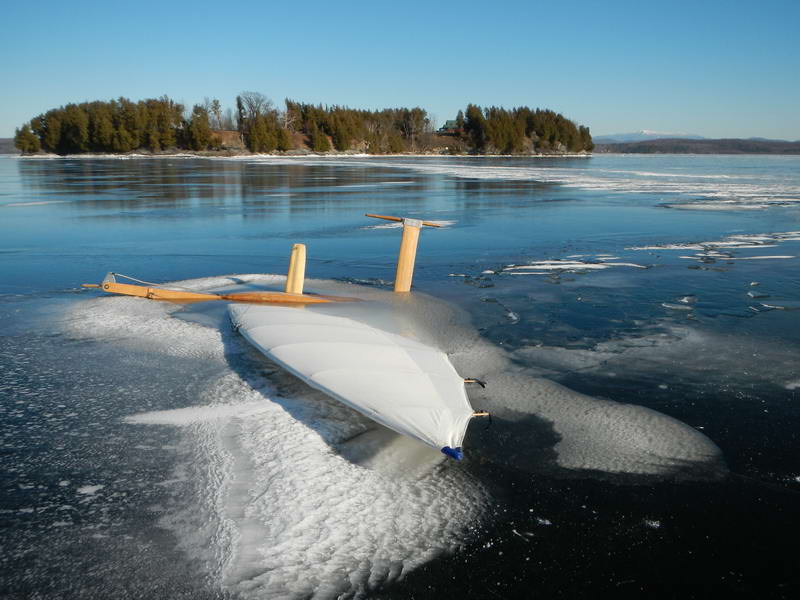How Thin is Too Thin?
Summary
On cold (below freezing) black ice, the minimum thickness that will not support a person on foot is called the breakthrough thickness. The 'can't get back on' thickness is ice that keeps breaking when you try to pull yourself back on with your ice claws. The thickness difference between 'breakthrough' thickness and 'can't get back on' thickness is small, maybe as little as 1/16" for adult body weights. This suggests that you should take extra precautions for things like skiing where your breakthrough thickness is reduced to below the 'can/t get back on' thickness.
The only way you should go out on ice any where near this thin is with a dry suit (or a wet suit) and with the intention of exploring the behavior of thin ice. You should have full equipment and a buddy to fish you out if needed. Shallow water is highly recommended.
Unless you are planning to fall though, thicker ice with a strength safety factor of three or more is needed. (More on recommended thickness of cold, black ice for a range of activities), (more on safety factors and bearing strength)
 Human Ice Tester: the author lounging in his drysuit and reasonably warm thanks to 3 layers of long underwear.
Human Ice Tester: the author lounging in his drysuit and reasonably warm thanks to 3 layers of long underwear.
Detail:
Based on experiments on thin black ice over shallow water, 180 lbs will probably break through 1.1" (28 mm) but probably won't break through at 1.2". There are lots of claims of being supported by 1" or even 1/2" ice. I have stepped on a lot of thin ice and I have never had 1" (25 mm) ice support my weight (about 175 lbs). The following table shows calculated breakthrough thicknesses for a wide range of weights:

This is based on the Gold Formula and extrapolated from pretty good data at 175 lbs (measurement uncertainty about 5%).
Getting back on the ice: If you weight 180 lbs and you are in a dry suit it looks like you should be able to get back on 1.1" ice in a prone position but you will probably break through if you stand up. One inch ice keeps breaking as you pull yourself onto the ice sheet with your ice claws! We have not determined the 'can't get on' thickness as accurately as we have with breakthrough thickness. In particular how much water is in your clothes and pack is a big factor. A dry suit retains relatively little water. Insulated clothes can easily bring out 30 or more lbs.
If you are on skis, a light iceboat or gliding on two skates you can get far out on ice that will be too thin to get back on after you break through. Reducing the risk of sailing onto ice you can not get back on requires that you be alert for frozen ice edges (where older/thicker ice meets newer ice) and the ice strength should be frequently measured with a test pole or other method. For skiing having a real ice testing pole is a good idea. For skating, you should skate so your weight is only on one foot at a time. This should raise your breakthrough thickness above the 'can't get on' thickness. You should never try to glide on both skates with your skates far apart in an effort to cross thin ice unless you have a short distance to go to certain thicker ice.
On a 15 degree day in January 2013, I found 27 mm (1.06") of new black ice would not hold me up (175 lbs). An hour later it had grown to 28 mm (1.1") and, while it was plenty noisy when stepped on, it held me up for the 60 feet I walked on it.
Note: the uncertainty of breakthrough thickness measurements is at least a mm (0.04").
Thin Spots: Ice thickens quickly when it is thin so there are likely to be local differences in when it caught and how fast it grew, resulting in variable thickness. Thin ice often has very few cracks to give an indication of thickness. Thin ice is dark so there is not much contrast between ice that is thick enough and ice that is not. Also, white splash-out rims may not have developed around any holes. This makes recently skinned over holes especially hard to spot. In general, ice thinner than two inches is more likely to have these issues. On cold back 2" ice the safety factor for a 180 lb person is about 3.
On ponds we know well, with full equipment (claws, test poles, throw ropes, dry clothing, floatation, etc), we will skate, with some trepidation, on subfreezing 2" black ice and sail DN's on 3". We are careful to keep some distance between us. So far we have had relatively few problems at that thickness. Over the years, we have had plenty of swims in the thinner areas that can often be found somewhere on a new ice sheet. On bigger ice or with less experience, less equipment or less risk tolerance, adding two or more inches is prudent.

This solo sailor sailed off the ice edge you can see in the upper background. The trail of broken ice just behind the boat is where the sailor clawed his way back to the edge. He was lucky he broke through where he did. If he had gotten further our he may not have been able to get back to thick ice. The ice at the time of the accident was about 2" thick where it was thick and 1" where he broke through. This picture was taken four cold days after the accident when the ice had thickened enough that we could retrieve the boat.
Ice Testing: A test pole (nordic skating poles, ice chisel, wood test pole) is the best way for a person traveling on foot to test ice thickness for ice less than three inches thick. Axes are popular in some areas. They are effective but are not as fast as a pole and they have a shorter handle. A drill is slower but is better for accurately measuring the ice thickness as a pole usually knocks out a cone of ice on the bottom of the ice sheet. If you want to know how thick it is you need to measure it with a tape or caliper. You can't get an accurate enough measurement by eye. You can measure at a hole you drilled, wet cracks, fishing holes, or by chipping a piece of the plate out with your pole (ice chisels work better for this).
In general, if you make a hole in the ice with your testing tool or a drill and water floods the ice around the hole the thickness has a safety margin of less than three.
Checking out a larger ice sheet: This is usually done mostly with a test pole as you venture out on the ice. Having a sense of what to be suspicious about is important as is whatever you can find out from people who have been out before you. Learning about what to look for takes a while. The learning process goes a lot faster if you go out with experienced people. It is unlikely that you will find every hazard. If you find one of anything, it is likely that there are more similar hazards.
Cracking: On cold ice. a single crack that forms as you move over the ice ('companion crack') may or may not mean it is too thin. Companion cracks can occur in fairly thick ice that is under some stress. None the less, any cracking that appears to be related to you is cause to verify the ice thickness with your test pole. If you are starting to see or hear cracks that are at right angles to your direction of travel (zipper cracks) or to see double cracks going in your direction, you are probably pushing the envelope. This is a great time to have on a dry suit, a life jacket and a throw rope in your buddy's pack (or, even better, to be doing something else while you wait for the ice to get thicker).
Silent Ice: No noise from the ice does not necessarily mean that it is reasonable to be on. If there is no cracking noise related to your moving across the ice it usually means one of three things:
- The ice is cold and thick (6+ inches)
- The ice is cold and between 3 and 6 inches and has a low amount of internal stress
- The ice is thin but warm.
I have been on quiet 1-3/4" (45 mm) smooth black ice (type S1) that had been thawed a bit by sun and warm weather. You could see the flashes of vacuum bubbles forming briefly as the ice grains shifted a little as we moved along. (We were fully equipped, tested the ice a lot and got off by mid-morning. ). This ice would have been quite noisy if it had been cold (fully frozen)
Shallow Water: The notion of staying over shallow water is reasonable but you may get just as wet if you break through. If you stay close to shore this may be a good strategy. If you have managed to skate, ski or sail far out on thin ice before you break through, you could still be in big trouble even though it is not over your head.
For a range of activities the Minnesota DNR recommendations for good black ice at temperatures below freezing are reasonably conservative. The minimum they recommend for fishermen is 4". This makes sense as three or four fishermen may end up in one portable shanty.
Warm Weather: The strength of thawed ice is significantly less than when it is below freezing. The thawing process takes place on the surface and internally so the thickness may not change much as it thaws and gets weaker. Ice less than a few inches thick thaws quickly: a couple hours might be enough. Even early in the thaw process it can lose 50% or more of its strength. In thick, highly thawed, small grain ice we have seen situations where it has lost 99% of its original strength. Snow ice gets particularly weak in thaw conditions as it turns to mush.
Practice: Click here for a Swedish video of part of the standard training procedure for skaters: finding out what it is really like to fall through thin ice. There are a bunch of these videos. They give a decent idea of what it is like to fall in at low speed, how getting back on the ice with ice claws goes, etc.
Where to expect thin ice: frozen ice edges, new-ice holes , any frozen over holes, around pressure ridges, under bridges, in and near swamps, .
Bob
More on the bearing strength of ice.
Lake Minnetonka WI. There were many breakthroughs and two fatalities on the lake in 2013. Most of them were associated with vehicles and the channels between the many bays on the lake. Channels like this are likely to have turbulence in the water under the ice with can cause under ice erosion. Bridges make the situation worse by blocking radiatonal cooling of the ice sheet.

